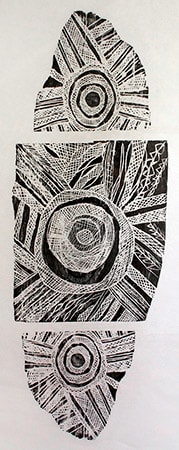Mulkun Wirrpanda Dhuḏi-Djapu, Dha-malamirr, b. 22/05/1942-2021
55 1/8 x 19 3/4 in
Buwakul is a salty bush yam found in the paperbark swamps. Mulkun Wirrpanda has been making a comprehensive series of barks, larrakitj and prints about the poorly recognised food plants of Northeast Arnhem Land. They figure plants and trees of various kinds which live in the Yirrkala region. This work is an example of a phase where the artist was influenced by her own motion to explore lesser known plant species which she feared were being forgotten by younger generations. This coincided with artist John Wolseley’s interest in returning to Yilpara (after he had met Mulkun during the Djalkiri project of 2010) and the two spent an extended period exploring the botany of Blue Mud Bay. Mulkun wanted to renew the knowledge of these plants because when she was young this is the food that she grew up on. In those days old people lived for a long time without illness. Most of the plant species which she has explored are not major parts of the sacred matrix of songs but Buwakul is an exception. It is featured in manikay (sacred song) of Bol’ngu the Thunderman. Bol’ngu is sung by several of the Dhuwa clans of N.E.Arnhemland. In ancestral time, Bol’ngu travelled from the Wessel Islands south through various Dhuwa moiety clans’ country. He was both man and cloud,the heavy cloud wolma -which brings the first rains of the wet season. He travelled in the clouds, and rain fell when he urinated. Associated with Bol’ngu are his spear Larrpan which is visible as a shooting star, his club ba`atj, which he throws to make thunder, and a curved strick he carries which symbolizes clouds. The yam buwakul is his food, and he is also associated with the paperbark tree which grows in swampy ground.The waterspout which sucks sea water into the clouds in Bulunu-the early dry season South-Easterly winds is a manifestation of Bol’ngu and bears his name. Bol’ngu is said to have seasonal influence on the weather - wind and rain As Bol’ngu travelled through the country, the Dhuwa clouds and the rain followed him. Rivers and creeks and springs with freshwater for the dry season formed. And he said to himself, “may it always be this way”. As he passed by, Bol’ngu named rivers and springs at sites he visited. He named trees and antbeds, and these are still the name for all these things at these places. buwakul Meaning :vine--climber, with edible root swellings Cayratia trifolia Language information: Language: Rit Other: A synonym of buwakul is: madjala[i', yoka[a Printed June 2014 FMP 15X


